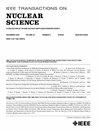Total Ionizing Dose Effects on Silicon Nitride Photonic Integrated Microring Resonators and Mach–Zehnder Interferometers
IF 1.9
3区 工程技术
Q3 ENGINEERING, ELECTRICAL & ELECTRONIC
引用次数: 0
Abstract
Silicon nitride (SiN) photonic integrated circuits (PICs) are a promising technology for satellite applications. In particular, they could be employed in satellite payloads for optical communications, allowing for the integration of optical functionalities on a chip, thus reducing the payload footprint. The research on the space environmental effects of this technology platform is still novel. Here, an experimental characterization of ionizing dose effects on integrated microring resonators (MRRs) and Mach-Zehnder interferometers (MZIs) is presented. Hundreds of devices with different waveguide widths were fabricated and characterized before and after irradiation, thanks to a highly automated setup. The impact of radiation in terms of additional losses, change in effective index, and change in the group index was evaluated. Furthermore, the long-term evolution of the effects after irradiation was also monitored. A change in the effective index as high as 2 × 10−3 and an increase in losses as large as 1 dB/cm were measured. The measured impact on the effective index and the group index, although relatively small, would be detrimental to applications such as wavelength filtering and/or (de)multiplexing and will need to be taken into account when designing devices for optical satellite communications.氮化硅光子集成微oring 谐振器和马赫-泽恩德干涉仪的总电离剂量效应
氮化硅(SiN)光子集成电路(pic)是一种很有前途的卫星应用技术。特别是,它们可以用于光通信的卫星有效载荷,允许在芯片上集成光学功能,从而减少有效载荷占地面积。该技术平台的空间环境效应研究还比较新颖。本文介绍了电离剂量对集成微环谐振器(MRRs)和马赫-曾德干涉仪(MZIs)的影响。由于高度自动化的设置,数百个具有不同波导宽度的器件在辐照前后被制造和表征。从附加损失、有效指数变化和组指数变化三个方面评价辐射的影响。此外,还监测了辐照后效应的长期演变。测量到的有效指数变化高达2 × 10−3,损耗增加高达1 dB/cm。测量到的对有效指数和群指数的影响虽然相对较小,但对波长滤波和/或(解)多路复用等应用是有害的,在设计光学卫星通信设备时需要考虑到这一点。
本文章由计算机程序翻译,如有差异,请以英文原文为准。
求助全文
约1分钟内获得全文
求助全文
来源期刊

IEEE Transactions on Nuclear Science
工程技术-工程:电子与电气
CiteScore
3.70
自引率
27.80%
发文量
314
审稿时长
6.2 months
期刊介绍:
The IEEE Transactions on Nuclear Science is a publication of the IEEE Nuclear and Plasma Sciences Society. It is viewed as the primary source of technical information in many of the areas it covers. As judged by JCR impact factor, TNS consistently ranks in the top five journals in the category of Nuclear Science & Technology. It has one of the higher immediacy indices, indicating that the information it publishes is viewed as timely, and has a relatively long citation half-life, indicating that the published information also is viewed as valuable for a number of years.
The IEEE Transactions on Nuclear Science is published bimonthly. Its scope includes all aspects of the theory and application of nuclear science and engineering. It focuses on instrumentation for the detection and measurement of ionizing radiation; particle accelerators and their controls; nuclear medicine and its application; effects of radiation on materials, components, and systems; reactor instrumentation and controls; and measurement of radiation in space.
 求助内容:
求助内容: 应助结果提醒方式:
应助结果提醒方式:


